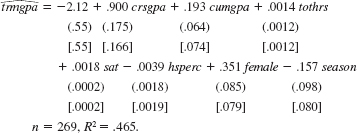
Introductory Econometrics 4th Edition by Jeffrey Wooldridge
Edition 4ISBN: 978-0324660609
Introductory Econometrics 4th Edition by Jeffrey Wooldridge
Edition 4ISBN: 978-0324660609 Exercise 3
The variable smokes is a binary variable equal to one if a person smokes, and zero otherwise. Using the data in SMOKE.RAW, we estimate a linear probability model for smokes: 
The variable white equals one if the respondent is white, and zero otherwise; the other independent variables are defined in Example 8.7. Both the usual and heteroskedasticity-robust standard errors are reported.
(i) Are there any important differences between the two sets of standard errors
(ii) Holding other factors fixed, if education increases by four years, what happens to the estimated probability of smoking
(iii) At what point does another year of age reduce the probability of smoking
(iv) Interpret the coefficient on the binary variable restaurn (a dummy variable equal to one if the person lives in a state with restaurant smoking restrictions).
(v) Person number 206 in the data set has the following characteristics: cigpric = 67.44, income = 6,500, educ = 16, age = 77, restaurn = 0, white = 0, and smokes = 0. Compute the predicted probability of smoking for this person and comment on the result.

The variable white equals one if the respondent is white, and zero otherwise; the other independent variables are defined in Example 8.7. Both the usual and heteroskedasticity-robust standard errors are reported.
(i) Are there any important differences between the two sets of standard errors
(ii) Holding other factors fixed, if education increases by four years, what happens to the estimated probability of smoking
(iii) At what point does another year of age reduce the probability of smoking
(iv) Interpret the coefficient on the binary variable restaurn (a dummy variable equal to one if the person lives in a state with restaurant smoking restrictions).
(v) Person number 206 in the data set has the following characteristics: cigpric = 67.44, income = 6,500, educ = 16, age = 77, restaurn = 0, white = 0, and smokes = 0. Compute the predicted probability of smoking for this person and comment on the result.
Explanation
(i)
On comparing the usual standard erro...
Introductory Econometrics 4th Edition by Jeffrey Wooldridge
Why don’t you like this exercise?
Other Minimum 8 character and maximum 255 character
Character 255



